Tesco HRM Strategies: Creating Value, Culture, and Compliance
VerifiedAdded on 2022/12/26
|13
|4124
|61
Report
AI Summary
This report examines Human Resource Management (HRM) strategies within Tesco, a multinational grocery retailer headquartered in London. It explores how Tesco creates value through its HR strategies, focusing on talent management, HR planning, leadership development, and performance appraisal, while adhering to legal requirements. The report also analyzes the impact of regional and national cultures on Tesco's HRM practices, including how cultural differences influence employee behavior and communication. Furthermore, it discusses Tesco's employment model and organizational levers used to create value, emphasizing strategic employments, maintaining a purpose-driven culture, and fostering relational trust. The distinction between HRM and Personnel Management is examined using Storey's 27 points, highlighting differences in contract focus, management style, and communication approaches. Finally, the report considers the importance of local culture in hiring and firing processes within transnational subsidiaries, as well as the impact of differing employment laws when implementing international HRM strategies. Corporate examples of firms using HR practices along with recommendations to employers regarding HR practices are also provided.
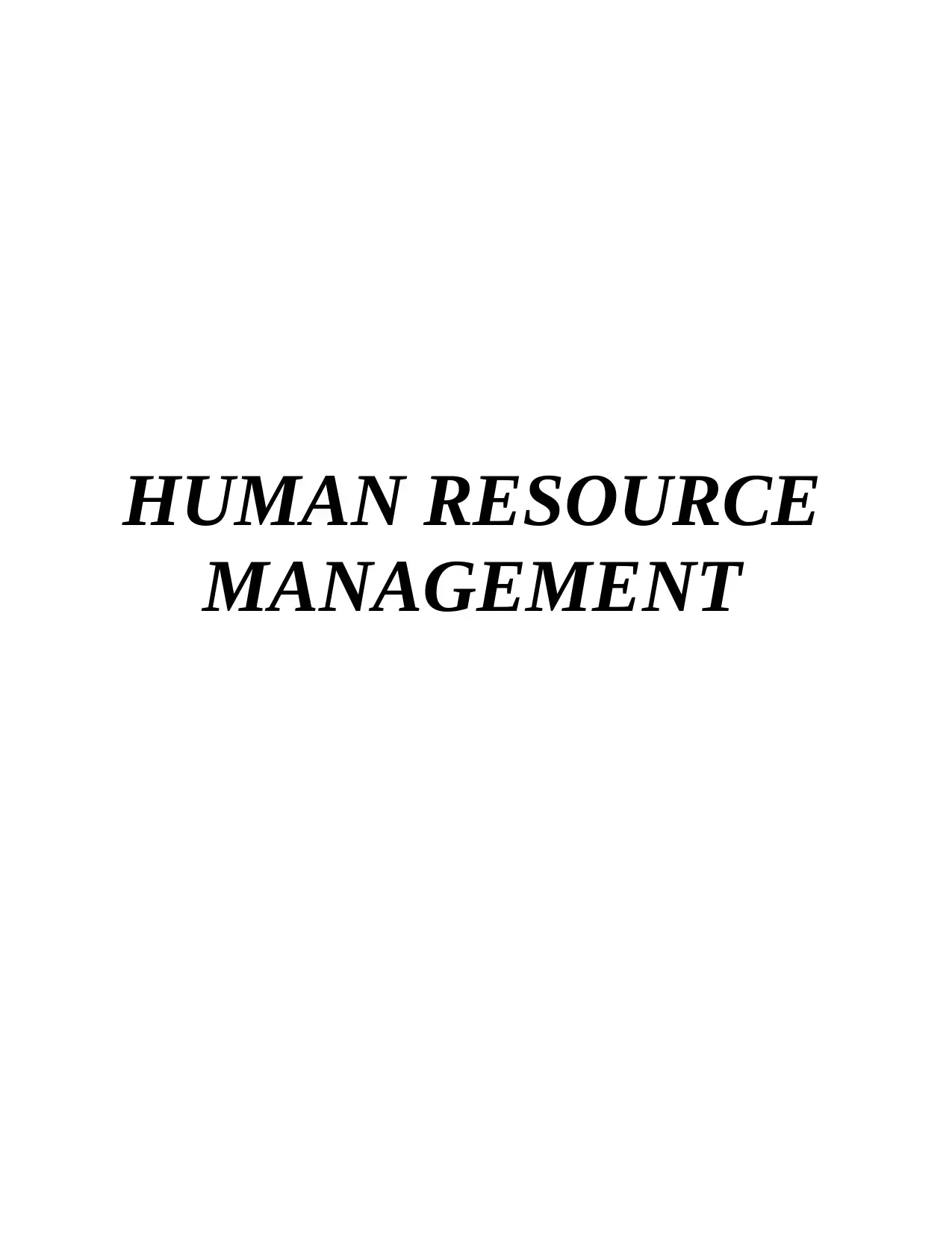
HUMAN RESOURCE
MANAGEMENT
MANAGEMENT
Paraphrase This Document
Need a fresh take? Get an instant paraphrase of this document with our AI Paraphraser
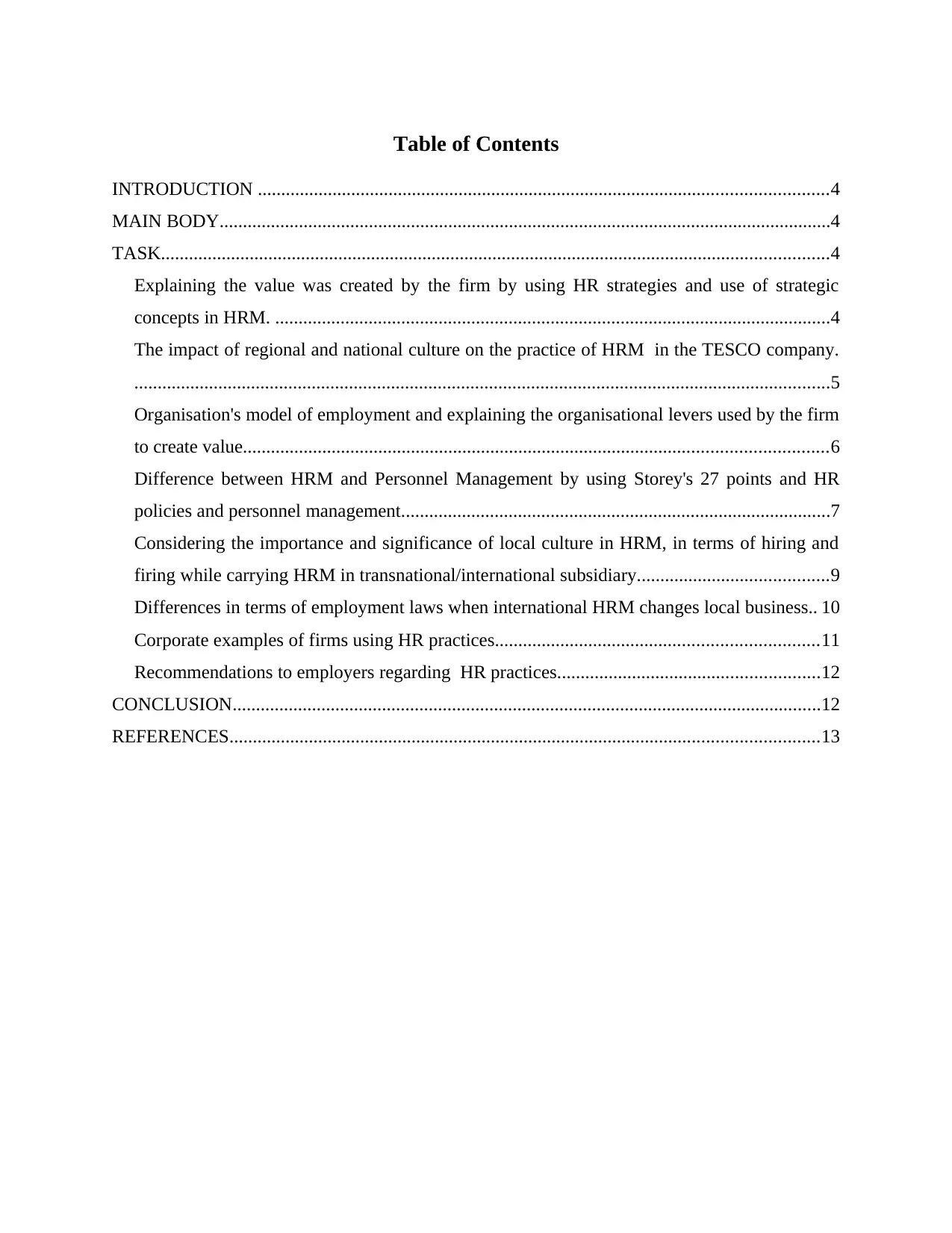
Table of Contents
INTRODUCTION ..........................................................................................................................4
MAIN BODY...................................................................................................................................4
TASK...............................................................................................................................................4
Explaining the value was created by the firm by using HR strategies and use of strategic
concepts in HRM. .......................................................................................................................4
The impact of regional and national culture on the practice of HRM in the TESCO company.
.....................................................................................................................................................5
Organisation's model of employment and explaining the organisational levers used by the firm
to create value.............................................................................................................................6
Difference between HRM and Personnel Management by using Storey's 27 points and HR
policies and personnel management............................................................................................7
Considering the importance and significance of local culture in HRM, in terms of hiring and
firing while carrying HRM in transnational/international subsidiary.........................................9
Differences in terms of employment laws when international HRM changes local business.. 10
Corporate examples of firms using HR practices.....................................................................11
Recommendations to employers regarding HR practices........................................................12
CONCLUSION..............................................................................................................................12
REFERENCES..............................................................................................................................13
INTRODUCTION ..........................................................................................................................4
MAIN BODY...................................................................................................................................4
TASK...............................................................................................................................................4
Explaining the value was created by the firm by using HR strategies and use of strategic
concepts in HRM. .......................................................................................................................4
The impact of regional and national culture on the practice of HRM in the TESCO company.
.....................................................................................................................................................5
Organisation's model of employment and explaining the organisational levers used by the firm
to create value.............................................................................................................................6
Difference between HRM and Personnel Management by using Storey's 27 points and HR
policies and personnel management............................................................................................7
Considering the importance and significance of local culture in HRM, in terms of hiring and
firing while carrying HRM in transnational/international subsidiary.........................................9
Differences in terms of employment laws when international HRM changes local business.. 10
Corporate examples of firms using HR practices.....................................................................11
Recommendations to employers regarding HR practices........................................................12
CONCLUSION..............................................................................................................................12
REFERENCES..............................................................................................................................13
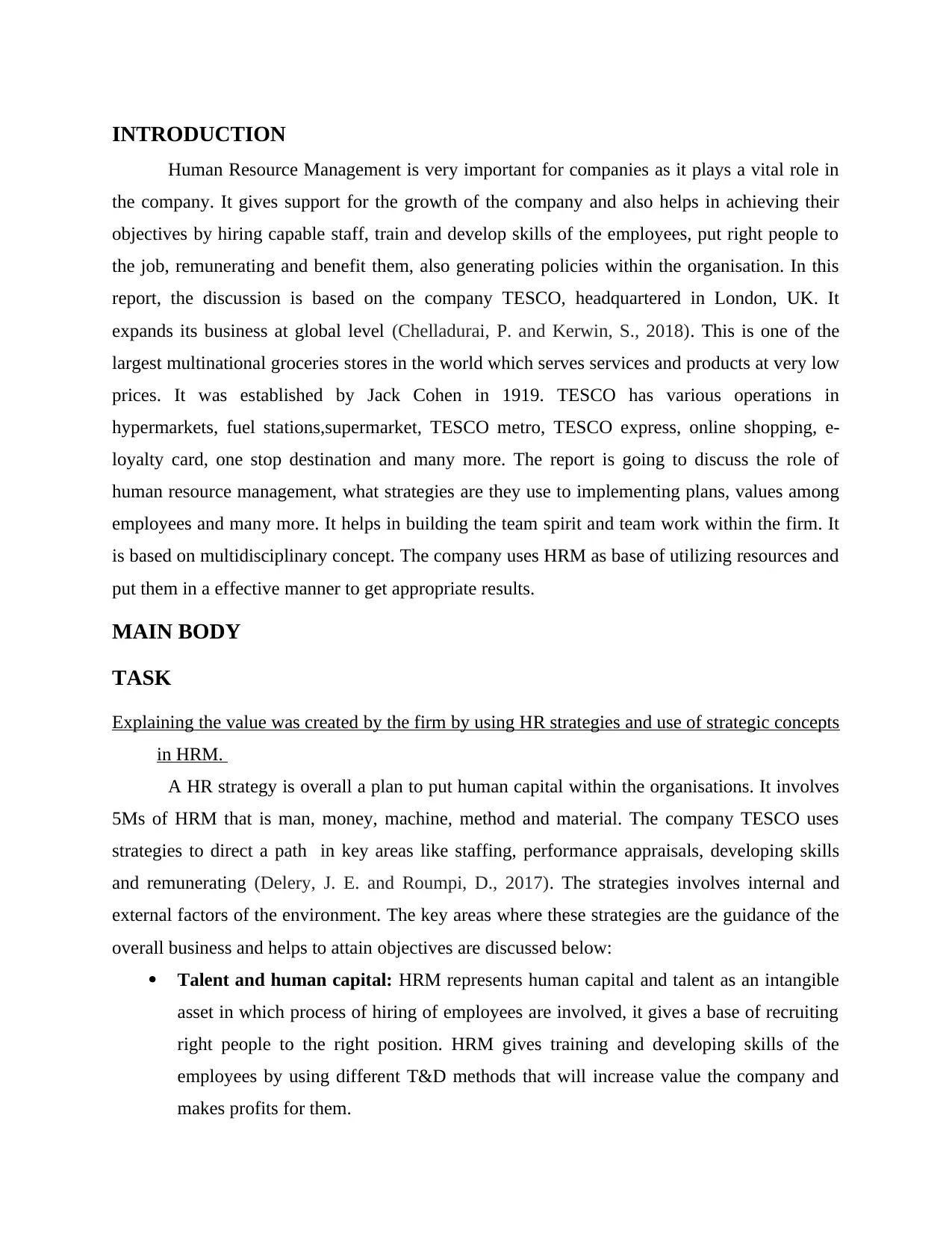
INTRODUCTION
Human Resource Management is very important for companies as it plays a vital role in
the company. It gives support for the growth of the company and also helps in achieving their
objectives by hiring capable staff, train and develop skills of the employees, put right people to
the job, remunerating and benefit them, also generating policies within the organisation. In this
report, the discussion is based on the company TESCO, headquartered in London, UK. It
expands its business at global level (Chelladurai, P. and Kerwin, S., 2018). This is one of the
largest multinational groceries stores in the world which serves services and products at very low
prices. It was established by Jack Cohen in 1919. TESCO has various operations in
hypermarkets, fuel stations,supermarket, TESCO metro, TESCO express, online shopping, e-
loyalty card, one stop destination and many more. The report is going to discuss the role of
human resource management, what strategies are they use to implementing plans, values among
employees and many more. It helps in building the team spirit and team work within the firm. It
is based on multidisciplinary concept. The company uses HRM as base of utilizing resources and
put them in a effective manner to get appropriate results.
MAIN BODY
TASK
Explaining the value was created by the firm by using HR strategies and use of strategic concepts
in HRM.
A HR strategy is overall a plan to put human capital within the organisations. It involves
5Ms of HRM that is man, money, machine, method and material. The company TESCO uses
strategies to direct a path in key areas like staffing, performance appraisals, developing skills
and remunerating (Delery, J. E. and Roumpi, D., 2017). The strategies involves internal and
external factors of the environment. The key areas where these strategies are the guidance of the
overall business and helps to attain objectives are discussed below:
Talent and human capital: HRM represents human capital and talent as an intangible
asset in which process of hiring of employees are involved, it gives a base of recruiting
right people to the right position. HRM gives training and developing skills of the
employees by using different T&D methods that will increase value the company and
makes profits for them.
Human Resource Management is very important for companies as it plays a vital role in
the company. It gives support for the growth of the company and also helps in achieving their
objectives by hiring capable staff, train and develop skills of the employees, put right people to
the job, remunerating and benefit them, also generating policies within the organisation. In this
report, the discussion is based on the company TESCO, headquartered in London, UK. It
expands its business at global level (Chelladurai, P. and Kerwin, S., 2018). This is one of the
largest multinational groceries stores in the world which serves services and products at very low
prices. It was established by Jack Cohen in 1919. TESCO has various operations in
hypermarkets, fuel stations,supermarket, TESCO metro, TESCO express, online shopping, e-
loyalty card, one stop destination and many more. The report is going to discuss the role of
human resource management, what strategies are they use to implementing plans, values among
employees and many more. It helps in building the team spirit and team work within the firm. It
is based on multidisciplinary concept. The company uses HRM as base of utilizing resources and
put them in a effective manner to get appropriate results.
MAIN BODY
TASK
Explaining the value was created by the firm by using HR strategies and use of strategic concepts
in HRM.
A HR strategy is overall a plan to put human capital within the organisations. It involves
5Ms of HRM that is man, money, machine, method and material. The company TESCO uses
strategies to direct a path in key areas like staffing, performance appraisals, developing skills
and remunerating (Delery, J. E. and Roumpi, D., 2017). The strategies involves internal and
external factors of the environment. The key areas where these strategies are the guidance of the
overall business and helps to attain objectives are discussed below:
Talent and human capital: HRM represents human capital and talent as an intangible
asset in which process of hiring of employees are involved, it gives a base of recruiting
right people to the right position. HRM gives training and developing skills of the
employees by using different T&D methods that will increase value the company and
makes profits for them.
⊘ This is a preview!⊘
Do you want full access?
Subscribe today to unlock all pages.

Trusted by 1+ million students worldwide
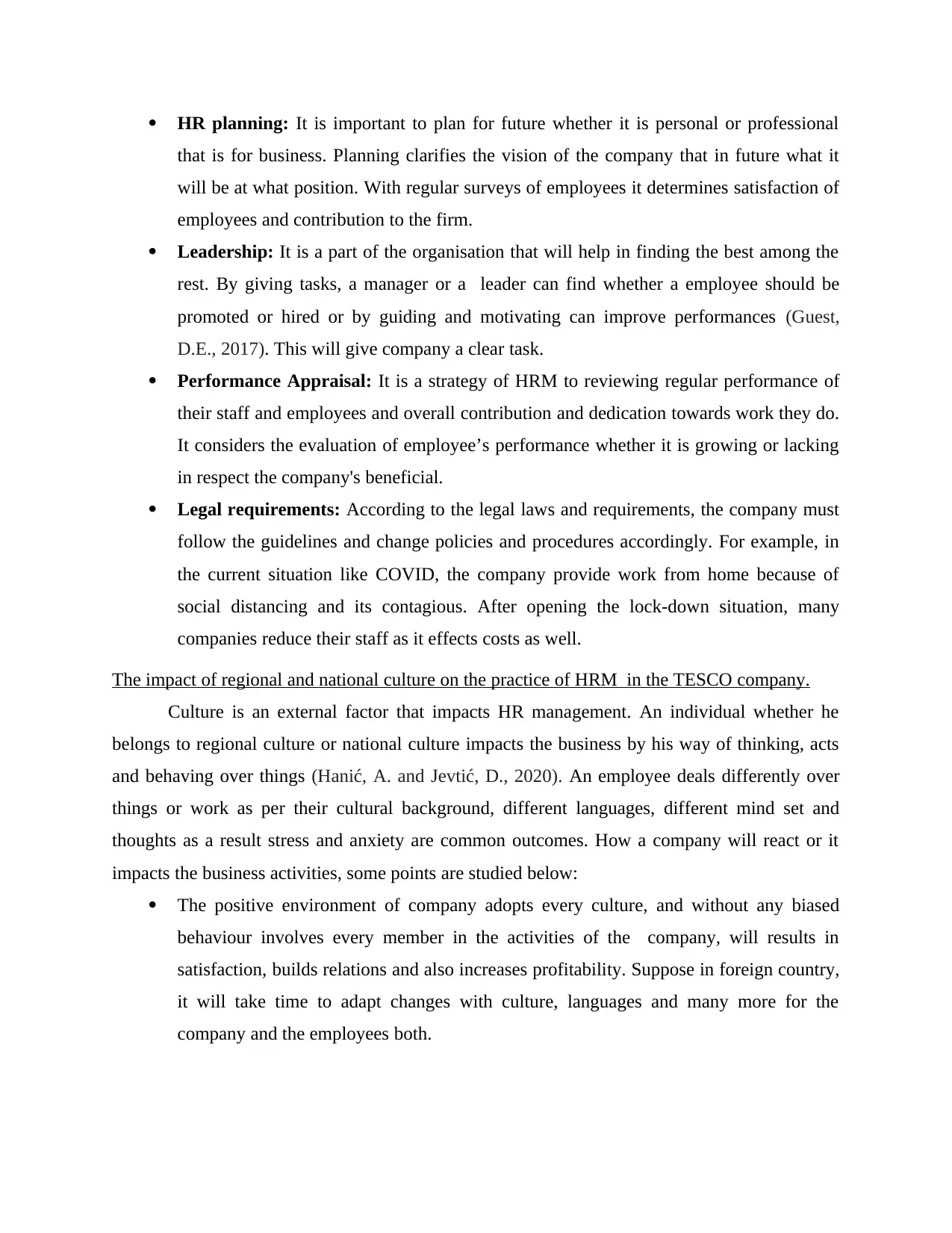
HR planning: It is important to plan for future whether it is personal or professional
that is for business. Planning clarifies the vision of the company that in future what it
will be at what position. With regular surveys of employees it determines satisfaction of
employees and contribution to the firm.
Leadership: It is a part of the organisation that will help in finding the best among the
rest. By giving tasks, a manager or a leader can find whether a employee should be
promoted or hired or by guiding and motivating can improve performances (Guest,
D.E., 2017). This will give company a clear task.
Performance Appraisal: It is a strategy of HRM to reviewing regular performance of
their staff and employees and overall contribution and dedication towards work they do.
It considers the evaluation of employee’s performance whether it is growing or lacking
in respect the company's beneficial.
Legal requirements: According to the legal laws and requirements, the company must
follow the guidelines and change policies and procedures accordingly. For example, in
the current situation like COVID, the company provide work from home because of
social distancing and its contagious. After opening the lock-down situation, many
companies reduce their staff as it effects costs as well.
The impact of regional and national culture on the practice of HRM in the TESCO company.
Culture is an external factor that impacts HR management. An individual whether he
belongs to regional culture or national culture impacts the business by his way of thinking, acts
and behaving over things (Hanić, A. and Jevtić, D., 2020). An employee deals differently over
things or work as per their cultural background, different languages, different mind set and
thoughts as a result stress and anxiety are common outcomes. How a company will react or it
impacts the business activities, some points are studied below:
The positive environment of company adopts every culture, and without any biased
behaviour involves every member in the activities of the company, will results in
satisfaction, builds relations and also increases profitability. Suppose in foreign country,
it will take time to adapt changes with culture, languages and many more for the
company and the employees both.
that is for business. Planning clarifies the vision of the company that in future what it
will be at what position. With regular surveys of employees it determines satisfaction of
employees and contribution to the firm.
Leadership: It is a part of the organisation that will help in finding the best among the
rest. By giving tasks, a manager or a leader can find whether a employee should be
promoted or hired or by guiding and motivating can improve performances (Guest,
D.E., 2017). This will give company a clear task.
Performance Appraisal: It is a strategy of HRM to reviewing regular performance of
their staff and employees and overall contribution and dedication towards work they do.
It considers the evaluation of employee’s performance whether it is growing or lacking
in respect the company's beneficial.
Legal requirements: According to the legal laws and requirements, the company must
follow the guidelines and change policies and procedures accordingly. For example, in
the current situation like COVID, the company provide work from home because of
social distancing and its contagious. After opening the lock-down situation, many
companies reduce their staff as it effects costs as well.
The impact of regional and national culture on the practice of HRM in the TESCO company.
Culture is an external factor that impacts HR management. An individual whether he
belongs to regional culture or national culture impacts the business by his way of thinking, acts
and behaving over things (Hanić, A. and Jevtić, D., 2020). An employee deals differently over
things or work as per their cultural background, different languages, different mind set and
thoughts as a result stress and anxiety are common outcomes. How a company will react or it
impacts the business activities, some points are studied below:
The positive environment of company adopts every culture, and without any biased
behaviour involves every member in the activities of the company, will results in
satisfaction, builds relations and also increases profitability. Suppose in foreign country,
it will take time to adapt changes with culture, languages and many more for the
company and the employees both.
Paraphrase This Document
Need a fresh take? Get an instant paraphrase of this document with our AI Paraphraser
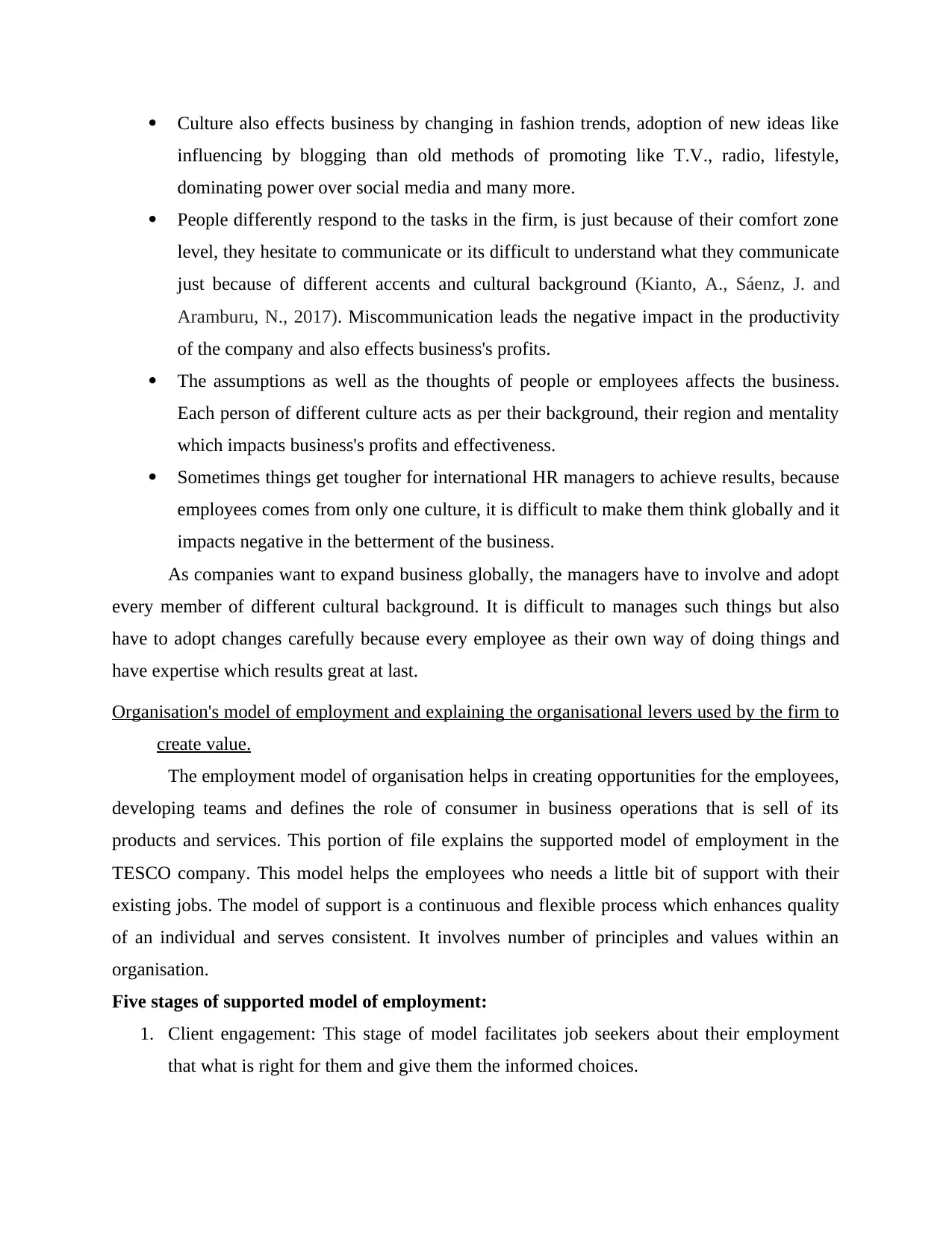
Culture also effects business by changing in fashion trends, adoption of new ideas like
influencing by blogging than old methods of promoting like T.V., radio, lifestyle,
dominating power over social media and many more.
People differently respond to the tasks in the firm, is just because of their comfort zone
level, they hesitate to communicate or its difficult to understand what they communicate
just because of different accents and cultural background (Kianto, A., Sáenz, J. and
Aramburu, N., 2017). Miscommunication leads the negative impact in the productivity
of the company and also effects business's profits.
The assumptions as well as the thoughts of people or employees affects the business.
Each person of different culture acts as per their background, their region and mentality
which impacts business's profits and effectiveness.
Sometimes things get tougher for international HR managers to achieve results, because
employees comes from only one culture, it is difficult to make them think globally and it
impacts negative in the betterment of the business.
As companies want to expand business globally, the managers have to involve and adopt
every member of different cultural background. It is difficult to manages such things but also
have to adopt changes carefully because every employee as their own way of doing things and
have expertise which results great at last.
Organisation's model of employment and explaining the organisational levers used by the firm to
create value.
The employment model of organisation helps in creating opportunities for the employees,
developing teams and defines the role of consumer in business operations that is sell of its
products and services. This portion of file explains the supported model of employment in the
TESCO company. This model helps the employees who needs a little bit of support with their
existing jobs. The model of support is a continuous and flexible process which enhances quality
of an individual and serves consistent. It involves number of principles and values within an
organisation.
Five stages of supported model of employment:
1. Client engagement: This stage of model facilitates job seekers about their employment
that what is right for them and give them the informed choices.
influencing by blogging than old methods of promoting like T.V., radio, lifestyle,
dominating power over social media and many more.
People differently respond to the tasks in the firm, is just because of their comfort zone
level, they hesitate to communicate or its difficult to understand what they communicate
just because of different accents and cultural background (Kianto, A., Sáenz, J. and
Aramburu, N., 2017). Miscommunication leads the negative impact in the productivity
of the company and also effects business's profits.
The assumptions as well as the thoughts of people or employees affects the business.
Each person of different culture acts as per their background, their region and mentality
which impacts business's profits and effectiveness.
Sometimes things get tougher for international HR managers to achieve results, because
employees comes from only one culture, it is difficult to make them think globally and it
impacts negative in the betterment of the business.
As companies want to expand business globally, the managers have to involve and adopt
every member of different cultural background. It is difficult to manages such things but also
have to adopt changes carefully because every employee as their own way of doing things and
have expertise which results great at last.
Organisation's model of employment and explaining the organisational levers used by the firm to
create value.
The employment model of organisation helps in creating opportunities for the employees,
developing teams and defines the role of consumer in business operations that is sell of its
products and services. This portion of file explains the supported model of employment in the
TESCO company. This model helps the employees who needs a little bit of support with their
existing jobs. The model of support is a continuous and flexible process which enhances quality
of an individual and serves consistent. It involves number of principles and values within an
organisation.
Five stages of supported model of employment:
1. Client engagement: This stage of model facilitates job seekers about their employment
that what is right for them and give them the informed choices.
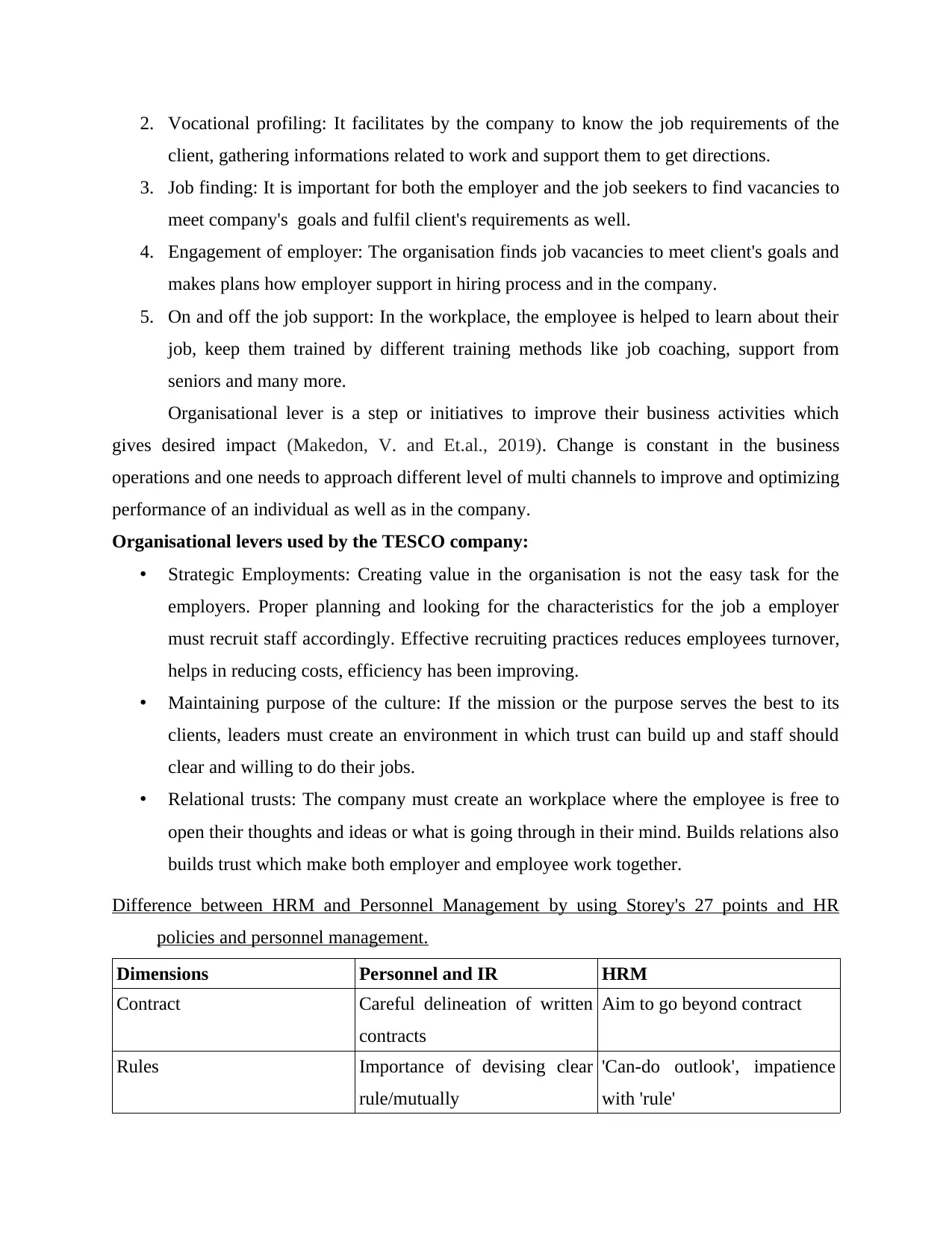
2. Vocational profiling: It facilitates by the company to know the job requirements of the
client, gathering informations related to work and support them to get directions.
3. Job finding: It is important for both the employer and the job seekers to find vacancies to
meet company's goals and fulfil client's requirements as well.
4. Engagement of employer: The organisation finds job vacancies to meet client's goals and
makes plans how employer support in hiring process and in the company.
5. On and off the job support: In the workplace, the employee is helped to learn about their
job, keep them trained by different training methods like job coaching, support from
seniors and many more.
Organisational lever is a step or initiatives to improve their business activities which
gives desired impact (Makedon, V. and Et.al., 2019). Change is constant in the business
operations and one needs to approach different level of multi channels to improve and optimizing
performance of an individual as well as in the company.
Organisational levers used by the TESCO company:
• Strategic Employments: Creating value in the organisation is not the easy task for the
employers. Proper planning and looking for the characteristics for the job a employer
must recruit staff accordingly. Effective recruiting practices reduces employees turnover,
helps in reducing costs, efficiency has been improving.
• Maintaining purpose of the culture: If the mission or the purpose serves the best to its
clients, leaders must create an environment in which trust can build up and staff should
clear and willing to do their jobs.
• Relational trusts: The company must create an workplace where the employee is free to
open their thoughts and ideas or what is going through in their mind. Builds relations also
builds trust which make both employer and employee work together.
Difference between HRM and Personnel Management by using Storey's 27 points and HR
policies and personnel management.
Dimensions Personnel and IR HRM
Contract Careful delineation of written
contracts
Aim to go beyond contract
Rules Importance of devising clear
rule/mutually
'Can-do outlook', impatience
with 'rule'
client, gathering informations related to work and support them to get directions.
3. Job finding: It is important for both the employer and the job seekers to find vacancies to
meet company's goals and fulfil client's requirements as well.
4. Engagement of employer: The organisation finds job vacancies to meet client's goals and
makes plans how employer support in hiring process and in the company.
5. On and off the job support: In the workplace, the employee is helped to learn about their
job, keep them trained by different training methods like job coaching, support from
seniors and many more.
Organisational lever is a step or initiatives to improve their business activities which
gives desired impact (Makedon, V. and Et.al., 2019). Change is constant in the business
operations and one needs to approach different level of multi channels to improve and optimizing
performance of an individual as well as in the company.
Organisational levers used by the TESCO company:
• Strategic Employments: Creating value in the organisation is not the easy task for the
employers. Proper planning and looking for the characteristics for the job a employer
must recruit staff accordingly. Effective recruiting practices reduces employees turnover,
helps in reducing costs, efficiency has been improving.
• Maintaining purpose of the culture: If the mission or the purpose serves the best to its
clients, leaders must create an environment in which trust can build up and staff should
clear and willing to do their jobs.
• Relational trusts: The company must create an workplace where the employee is free to
open their thoughts and ideas or what is going through in their mind. Builds relations also
builds trust which make both employer and employee work together.
Difference between HRM and Personnel Management by using Storey's 27 points and HR
policies and personnel management.
Dimensions Personnel and IR HRM
Contract Careful delineation of written
contracts
Aim to go beyond contract
Rules Importance of devising clear
rule/mutually
'Can-do outlook', impatience
with 'rule'
⊘ This is a preview!⊘
Do you want full access?
Subscribe today to unlock all pages.

Trusted by 1+ million students worldwide
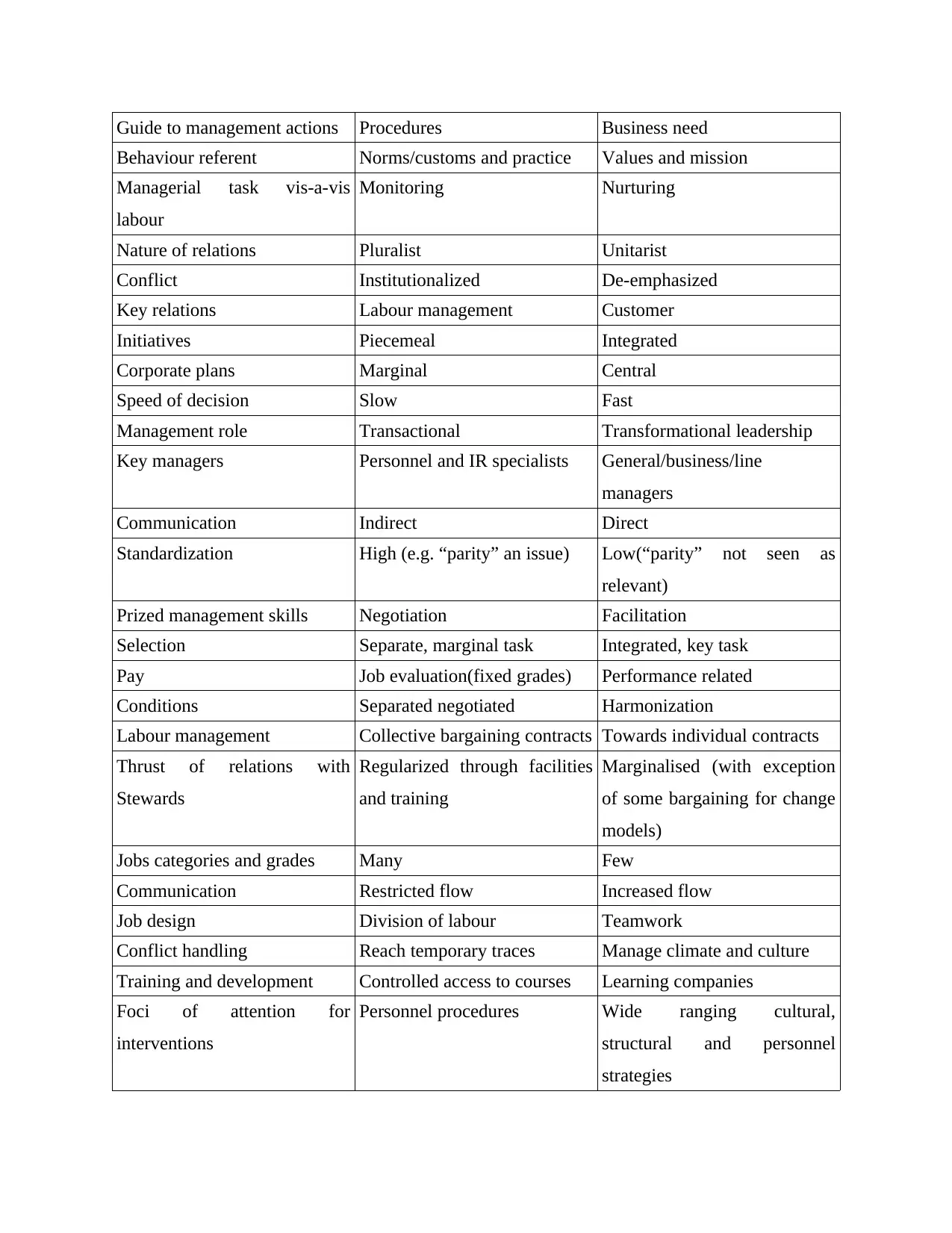
Guide to management actions Procedures Business need
Behaviour referent Norms/customs and practice Values and mission
Managerial task vis-a-vis
labour
Monitoring Nurturing
Nature of relations Pluralist Unitarist
Conflict Institutionalized De-emphasized
Key relations Labour management Customer
Initiatives Piecemeal Integrated
Corporate plans Marginal Central
Speed of decision Slow Fast
Management role Transactional Transformational leadership
Key managers Personnel and IR specialists General/business/line
managers
Communication Indirect Direct
Standardization High (e.g. “parity” an issue) Low(“parity” not seen as
relevant)
Prized management skills Negotiation Facilitation
Selection Separate, marginal task Integrated, key task
Pay Job evaluation(fixed grades) Performance related
Conditions Separated negotiated Harmonization
Labour management Collective bargaining contracts Towards individual contracts
Thrust of relations with
Stewards
Regularized through facilities
and training
Marginalised (with exception
of some bargaining for change
models)
Jobs categories and grades Many Few
Communication Restricted flow Increased flow
Job design Division of labour Teamwork
Conflict handling Reach temporary traces Manage climate and culture
Training and development Controlled access to courses Learning companies
Foci of attention for
interventions
Personnel procedures Wide ranging cultural,
structural and personnel
strategies
Behaviour referent Norms/customs and practice Values and mission
Managerial task vis-a-vis
labour
Monitoring Nurturing
Nature of relations Pluralist Unitarist
Conflict Institutionalized De-emphasized
Key relations Labour management Customer
Initiatives Piecemeal Integrated
Corporate plans Marginal Central
Speed of decision Slow Fast
Management role Transactional Transformational leadership
Key managers Personnel and IR specialists General/business/line
managers
Communication Indirect Direct
Standardization High (e.g. “parity” an issue) Low(“parity” not seen as
relevant)
Prized management skills Negotiation Facilitation
Selection Separate, marginal task Integrated, key task
Pay Job evaluation(fixed grades) Performance related
Conditions Separated negotiated Harmonization
Labour management Collective bargaining contracts Towards individual contracts
Thrust of relations with
Stewards
Regularized through facilities
and training
Marginalised (with exception
of some bargaining for change
models)
Jobs categories and grades Many Few
Communication Restricted flow Increased flow
Job design Division of labour Teamwork
Conflict handling Reach temporary traces Manage climate and culture
Training and development Controlled access to courses Learning companies
Foci of attention for
interventions
Personnel procedures Wide ranging cultural,
structural and personnel
strategies
Paraphrase This Document
Need a fresh take? Get an instant paraphrase of this document with our AI Paraphraser
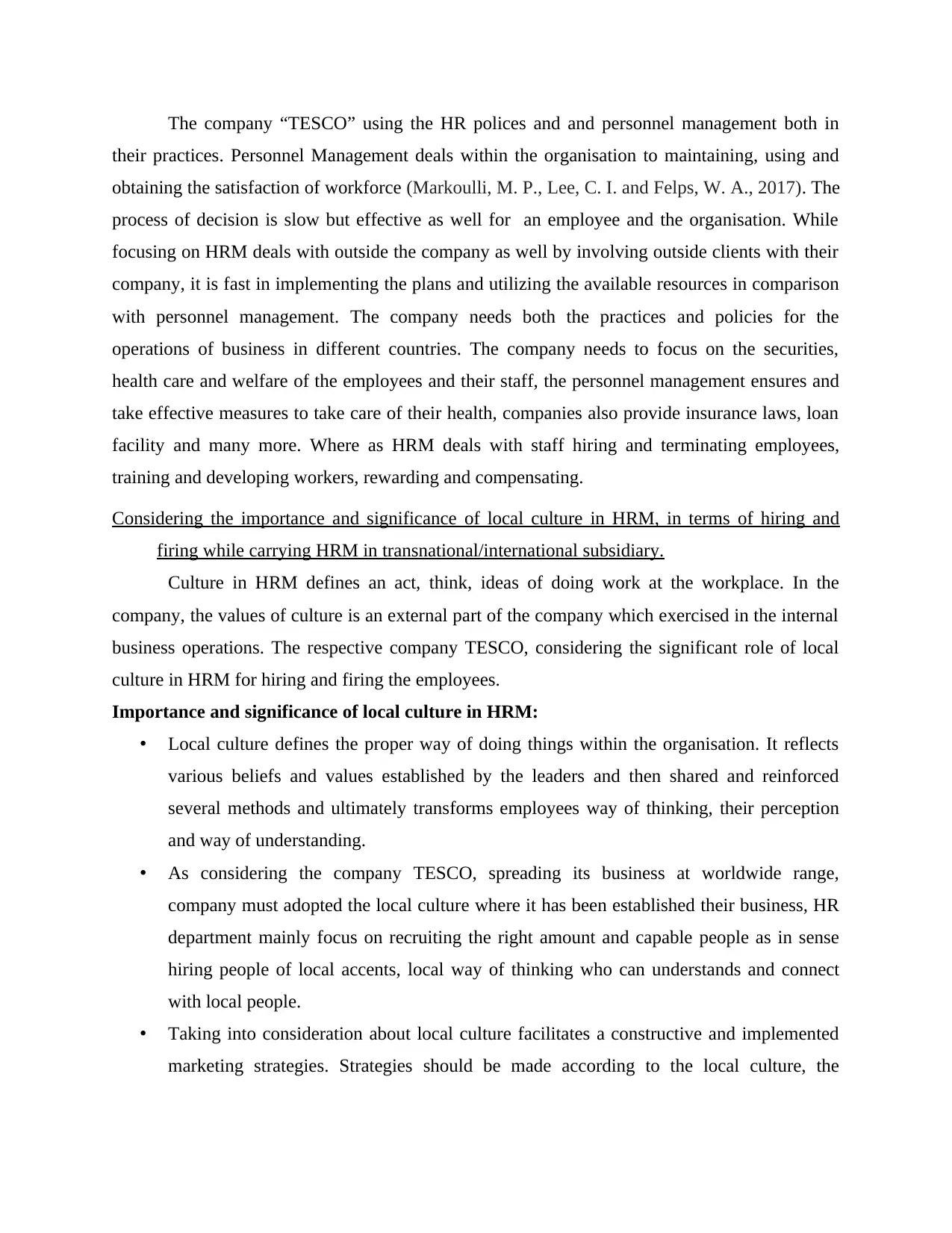
The company “TESCO” using the HR polices and and personnel management both in
their practices. Personnel Management deals within the organisation to maintaining, using and
obtaining the satisfaction of workforce (Markoulli, M. P., Lee, C. I. and Felps, W. A., 2017). The
process of decision is slow but effective as well for an employee and the organisation. While
focusing on HRM deals with outside the company as well by involving outside clients with their
company, it is fast in implementing the plans and utilizing the available resources in comparison
with personnel management. The company needs both the practices and policies for the
operations of business in different countries. The company needs to focus on the securities,
health care and welfare of the employees and their staff, the personnel management ensures and
take effective measures to take care of their health, companies also provide insurance laws, loan
facility and many more. Where as HRM deals with staff hiring and terminating employees,
training and developing workers, rewarding and compensating.
Considering the importance and significance of local culture in HRM, in terms of hiring and
firing while carrying HRM in transnational/international subsidiary.
Culture in HRM defines an act, think, ideas of doing work at the workplace. In the
company, the values of culture is an external part of the company which exercised in the internal
business operations. The respective company TESCO, considering the significant role of local
culture in HRM for hiring and firing the employees.
Importance and significance of local culture in HRM:
• Local culture defines the proper way of doing things within the organisation. It reflects
various beliefs and values established by the leaders and then shared and reinforced
several methods and ultimately transforms employees way of thinking, their perception
and way of understanding.
• As considering the company TESCO, spreading its business at worldwide range,
company must adopted the local culture where it has been established their business, HR
department mainly focus on recruiting the right amount and capable people as in sense
hiring people of local accents, local way of thinking who can understands and connect
with local people.
• Taking into consideration about local culture facilitates a constructive and implemented
marketing strategies. Strategies should be made according to the local culture, the
their practices. Personnel Management deals within the organisation to maintaining, using and
obtaining the satisfaction of workforce (Markoulli, M. P., Lee, C. I. and Felps, W. A., 2017). The
process of decision is slow but effective as well for an employee and the organisation. While
focusing on HRM deals with outside the company as well by involving outside clients with their
company, it is fast in implementing the plans and utilizing the available resources in comparison
with personnel management. The company needs both the practices and policies for the
operations of business in different countries. The company needs to focus on the securities,
health care and welfare of the employees and their staff, the personnel management ensures and
take effective measures to take care of their health, companies also provide insurance laws, loan
facility and many more. Where as HRM deals with staff hiring and terminating employees,
training and developing workers, rewarding and compensating.
Considering the importance and significance of local culture in HRM, in terms of hiring and
firing while carrying HRM in transnational/international subsidiary.
Culture in HRM defines an act, think, ideas of doing work at the workplace. In the
company, the values of culture is an external part of the company which exercised in the internal
business operations. The respective company TESCO, considering the significant role of local
culture in HRM for hiring and firing the employees.
Importance and significance of local culture in HRM:
• Local culture defines the proper way of doing things within the organisation. It reflects
various beliefs and values established by the leaders and then shared and reinforced
several methods and ultimately transforms employees way of thinking, their perception
and way of understanding.
• As considering the company TESCO, spreading its business at worldwide range,
company must adopted the local culture where it has been established their business, HR
department mainly focus on recruiting the right amount and capable people as in sense
hiring people of local accents, local way of thinking who can understands and connect
with local people.
• Taking into consideration about local culture facilitates a constructive and implemented
marketing strategies. Strategies should be made according to the local culture, the
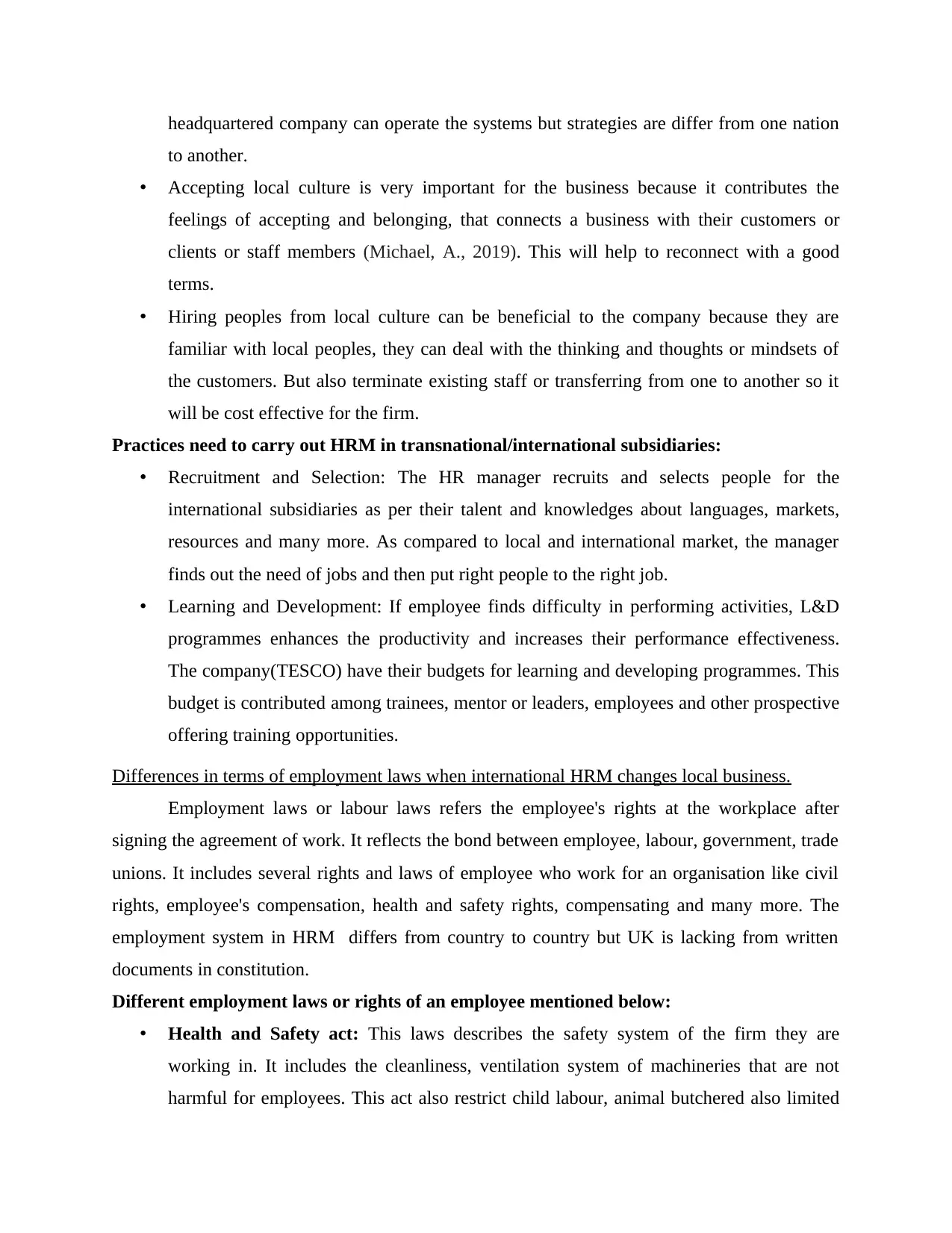
headquartered company can operate the systems but strategies are differ from one nation
to another.
• Accepting local culture is very important for the business because it contributes the
feelings of accepting and belonging, that connects a business with their customers or
clients or staff members (Michael, A., 2019). This will help to reconnect with a good
terms.
• Hiring peoples from local culture can be beneficial to the company because they are
familiar with local peoples, they can deal with the thinking and thoughts or mindsets of
the customers. But also terminate existing staff or transferring from one to another so it
will be cost effective for the firm.
Practices need to carry out HRM in transnational/international subsidiaries:
• Recruitment and Selection: The HR manager recruits and selects people for the
international subsidiaries as per their talent and knowledges about languages, markets,
resources and many more. As compared to local and international market, the manager
finds out the need of jobs and then put right people to the right job.
• Learning and Development: If employee finds difficulty in performing activities, L&D
programmes enhances the productivity and increases their performance effectiveness.
The company(TESCO) have their budgets for learning and developing programmes. This
budget is contributed among trainees, mentor or leaders, employees and other prospective
offering training opportunities.
Differences in terms of employment laws when international HRM changes local business.
Employment laws or labour laws refers the employee's rights at the workplace after
signing the agreement of work. It reflects the bond between employee, labour, government, trade
unions. It includes several rights and laws of employee who work for an organisation like civil
rights, employee's compensation, health and safety rights, compensating and many more. The
employment system in HRM differs from country to country but UK is lacking from written
documents in constitution.
Different employment laws or rights of an employee mentioned below:
• Health and Safety act: This laws describes the safety system of the firm they are
working in. It includes the cleanliness, ventilation system of machineries that are not
harmful for employees. This act also restrict child labour, animal butchered also limited
to another.
• Accepting local culture is very important for the business because it contributes the
feelings of accepting and belonging, that connects a business with their customers or
clients or staff members (Michael, A., 2019). This will help to reconnect with a good
terms.
• Hiring peoples from local culture can be beneficial to the company because they are
familiar with local peoples, they can deal with the thinking and thoughts or mindsets of
the customers. But also terminate existing staff or transferring from one to another so it
will be cost effective for the firm.
Practices need to carry out HRM in transnational/international subsidiaries:
• Recruitment and Selection: The HR manager recruits and selects people for the
international subsidiaries as per their talent and knowledges about languages, markets,
resources and many more. As compared to local and international market, the manager
finds out the need of jobs and then put right people to the right job.
• Learning and Development: If employee finds difficulty in performing activities, L&D
programmes enhances the productivity and increases their performance effectiveness.
The company(TESCO) have their budgets for learning and developing programmes. This
budget is contributed among trainees, mentor or leaders, employees and other prospective
offering training opportunities.
Differences in terms of employment laws when international HRM changes local business.
Employment laws or labour laws refers the employee's rights at the workplace after
signing the agreement of work. It reflects the bond between employee, labour, government, trade
unions. It includes several rights and laws of employee who work for an organisation like civil
rights, employee's compensation, health and safety rights, compensating and many more. The
employment system in HRM differs from country to country but UK is lacking from written
documents in constitution.
Different employment laws or rights of an employee mentioned below:
• Health and Safety act: This laws describes the safety system of the firm they are
working in. It includes the cleanliness, ventilation system of machineries that are not
harmful for employees. This act also restrict child labour, animal butchered also limited
⊘ This is a preview!⊘
Do you want full access?
Subscribe today to unlock all pages.

Trusted by 1+ million students worldwide
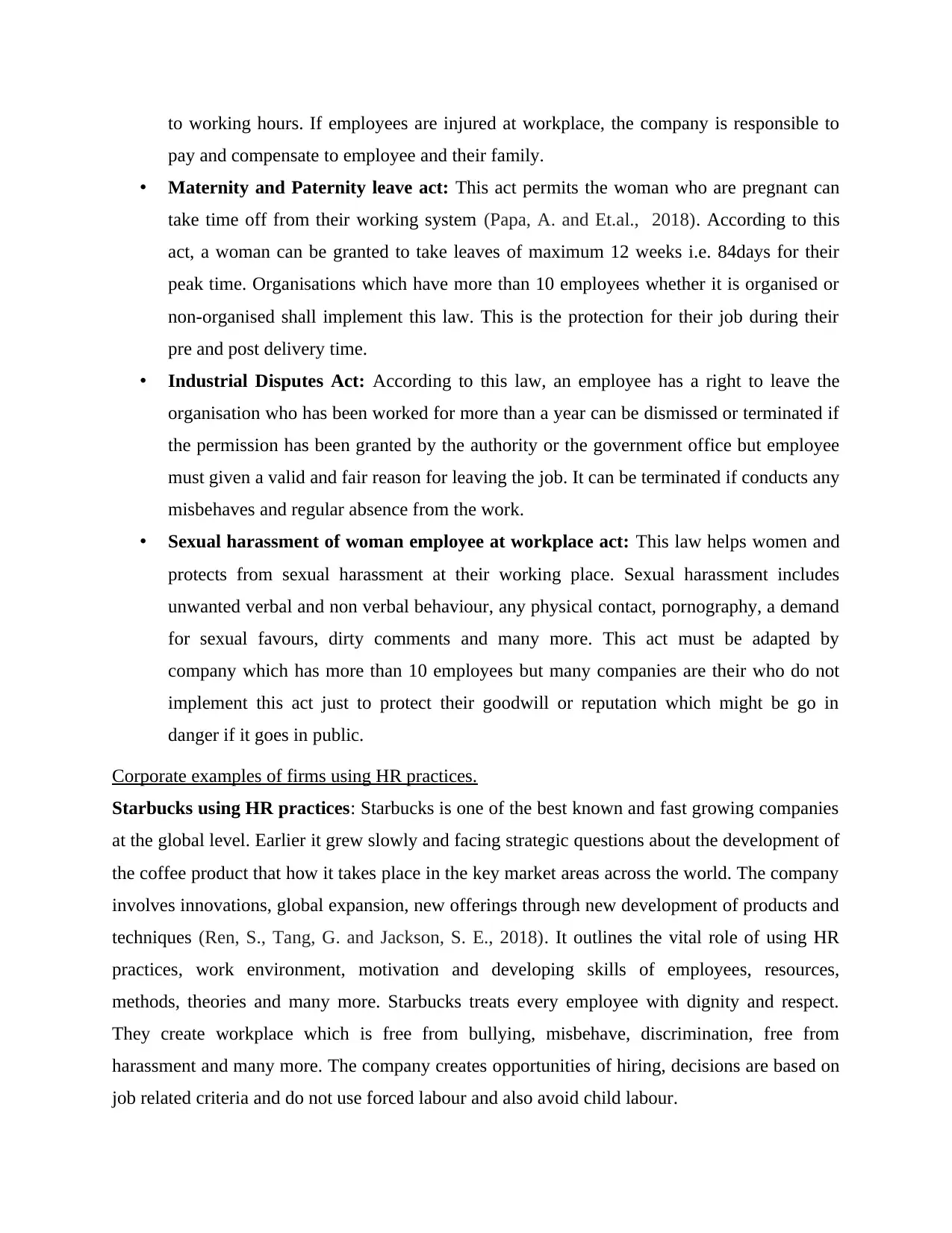
to working hours. If employees are injured at workplace, the company is responsible to
pay and compensate to employee and their family.
• Maternity and Paternity leave act: This act permits the woman who are pregnant can
take time off from their working system (Papa, A. and Et.al., 2018). According to this
act, a woman can be granted to take leaves of maximum 12 weeks i.e. 84days for their
peak time. Organisations which have more than 10 employees whether it is organised or
non-organised shall implement this law. This is the protection for their job during their
pre and post delivery time.
• Industrial Disputes Act: According to this law, an employee has a right to leave the
organisation who has been worked for more than a year can be dismissed or terminated if
the permission has been granted by the authority or the government office but employee
must given a valid and fair reason for leaving the job. It can be terminated if conducts any
misbehaves and regular absence from the work.
• Sexual harassment of woman employee at workplace act: This law helps women and
protects from sexual harassment at their working place. Sexual harassment includes
unwanted verbal and non verbal behaviour, any physical contact, pornography, a demand
for sexual favours, dirty comments and many more. This act must be adapted by
company which has more than 10 employees but many companies are their who do not
implement this act just to protect their goodwill or reputation which might be go in
danger if it goes in public.
Corporate examples of firms using HR practices.
Starbucks using HR practices: Starbucks is one of the best known and fast growing companies
at the global level. Earlier it grew slowly and facing strategic questions about the development of
the coffee product that how it takes place in the key market areas across the world. The company
involves innovations, global expansion, new offerings through new development of products and
techniques (Ren, S., Tang, G. and Jackson, S. E., 2018). It outlines the vital role of using HR
practices, work environment, motivation and developing skills of employees, resources,
methods, theories and many more. Starbucks treats every employee with dignity and respect.
They create workplace which is free from bullying, misbehave, discrimination, free from
harassment and many more. The company creates opportunities of hiring, decisions are based on
job related criteria and do not use forced labour and also avoid child labour.
pay and compensate to employee and their family.
• Maternity and Paternity leave act: This act permits the woman who are pregnant can
take time off from their working system (Papa, A. and Et.al., 2018). According to this
act, a woman can be granted to take leaves of maximum 12 weeks i.e. 84days for their
peak time. Organisations which have more than 10 employees whether it is organised or
non-organised shall implement this law. This is the protection for their job during their
pre and post delivery time.
• Industrial Disputes Act: According to this law, an employee has a right to leave the
organisation who has been worked for more than a year can be dismissed or terminated if
the permission has been granted by the authority or the government office but employee
must given a valid and fair reason for leaving the job. It can be terminated if conducts any
misbehaves and regular absence from the work.
• Sexual harassment of woman employee at workplace act: This law helps women and
protects from sexual harassment at their working place. Sexual harassment includes
unwanted verbal and non verbal behaviour, any physical contact, pornography, a demand
for sexual favours, dirty comments and many more. This act must be adapted by
company which has more than 10 employees but many companies are their who do not
implement this act just to protect their goodwill or reputation which might be go in
danger if it goes in public.
Corporate examples of firms using HR practices.
Starbucks using HR practices: Starbucks is one of the best known and fast growing companies
at the global level. Earlier it grew slowly and facing strategic questions about the development of
the coffee product that how it takes place in the key market areas across the world. The company
involves innovations, global expansion, new offerings through new development of products and
techniques (Ren, S., Tang, G. and Jackson, S. E., 2018). It outlines the vital role of using HR
practices, work environment, motivation and developing skills of employees, resources,
methods, theories and many more. Starbucks treats every employee with dignity and respect.
They create workplace which is free from bullying, misbehave, discrimination, free from
harassment and many more. The company creates opportunities of hiring, decisions are based on
job related criteria and do not use forced labour and also avoid child labour.
Paraphrase This Document
Need a fresh take? Get an instant paraphrase of this document with our AI Paraphraser
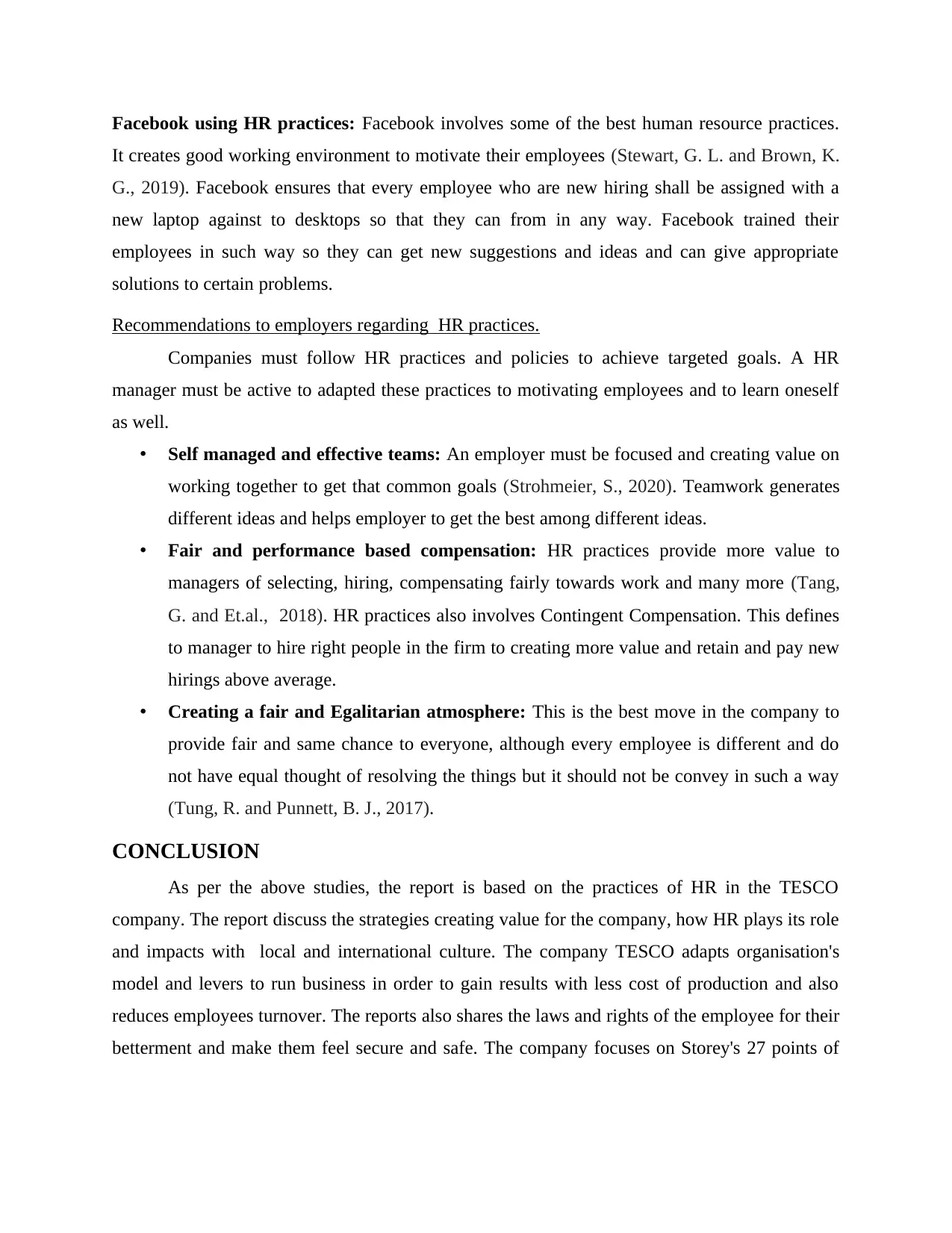
Facebook using HR practices: Facebook involves some of the best human resource practices.
It creates good working environment to motivate their employees (Stewart, G. L. and Brown, K.
G., 2019). Facebook ensures that every employee who are new hiring shall be assigned with a
new laptop against to desktops so that they can from in any way. Facebook trained their
employees in such way so they can get new suggestions and ideas and can give appropriate
solutions to certain problems.
Recommendations to employers regarding HR practices.
Companies must follow HR practices and policies to achieve targeted goals. A HR
manager must be active to adapted these practices to motivating employees and to learn oneself
as well.
• Self managed and effective teams: An employer must be focused and creating value on
working together to get that common goals (Strohmeier, S., 2020). Teamwork generates
different ideas and helps employer to get the best among different ideas.
• Fair and performance based compensation: HR practices provide more value to
managers of selecting, hiring, compensating fairly towards work and many more (Tang,
G. and Et.al., 2018). HR practices also involves Contingent Compensation. This defines
to manager to hire right people in the firm to creating more value and retain and pay new
hirings above average.
• Creating a fair and Egalitarian atmosphere: This is the best move in the company to
provide fair and same chance to everyone, although every employee is different and do
not have equal thought of resolving the things but it should not be convey in such a way
(Tung, R. and Punnett, B. J., 2017).
CONCLUSION
As per the above studies, the report is based on the practices of HR in the TESCO
company. The report discuss the strategies creating value for the company, how HR plays its role
and impacts with local and international culture. The company TESCO adapts organisation's
model and levers to run business in order to gain results with less cost of production and also
reduces employees turnover. The reports also shares the laws and rights of the employee for their
betterment and make them feel secure and safe. The company focuses on Storey's 27 points of
It creates good working environment to motivate their employees (Stewart, G. L. and Brown, K.
G., 2019). Facebook ensures that every employee who are new hiring shall be assigned with a
new laptop against to desktops so that they can from in any way. Facebook trained their
employees in such way so they can get new suggestions and ideas and can give appropriate
solutions to certain problems.
Recommendations to employers regarding HR practices.
Companies must follow HR practices and policies to achieve targeted goals. A HR
manager must be active to adapted these practices to motivating employees and to learn oneself
as well.
• Self managed and effective teams: An employer must be focused and creating value on
working together to get that common goals (Strohmeier, S., 2020). Teamwork generates
different ideas and helps employer to get the best among different ideas.
• Fair and performance based compensation: HR practices provide more value to
managers of selecting, hiring, compensating fairly towards work and many more (Tang,
G. and Et.al., 2018). HR practices also involves Contingent Compensation. This defines
to manager to hire right people in the firm to creating more value and retain and pay new
hirings above average.
• Creating a fair and Egalitarian atmosphere: This is the best move in the company to
provide fair and same chance to everyone, although every employee is different and do
not have equal thought of resolving the things but it should not be convey in such a way
(Tung, R. and Punnett, B. J., 2017).
CONCLUSION
As per the above studies, the report is based on the practices of HR in the TESCO
company. The report discuss the strategies creating value for the company, how HR plays its role
and impacts with local and international culture. The company TESCO adapts organisation's
model and levers to run business in order to gain results with less cost of production and also
reduces employees turnover. The reports also shares the laws and rights of the employee for their
betterment and make them feel secure and safe. The company focuses on Storey's 27 points of
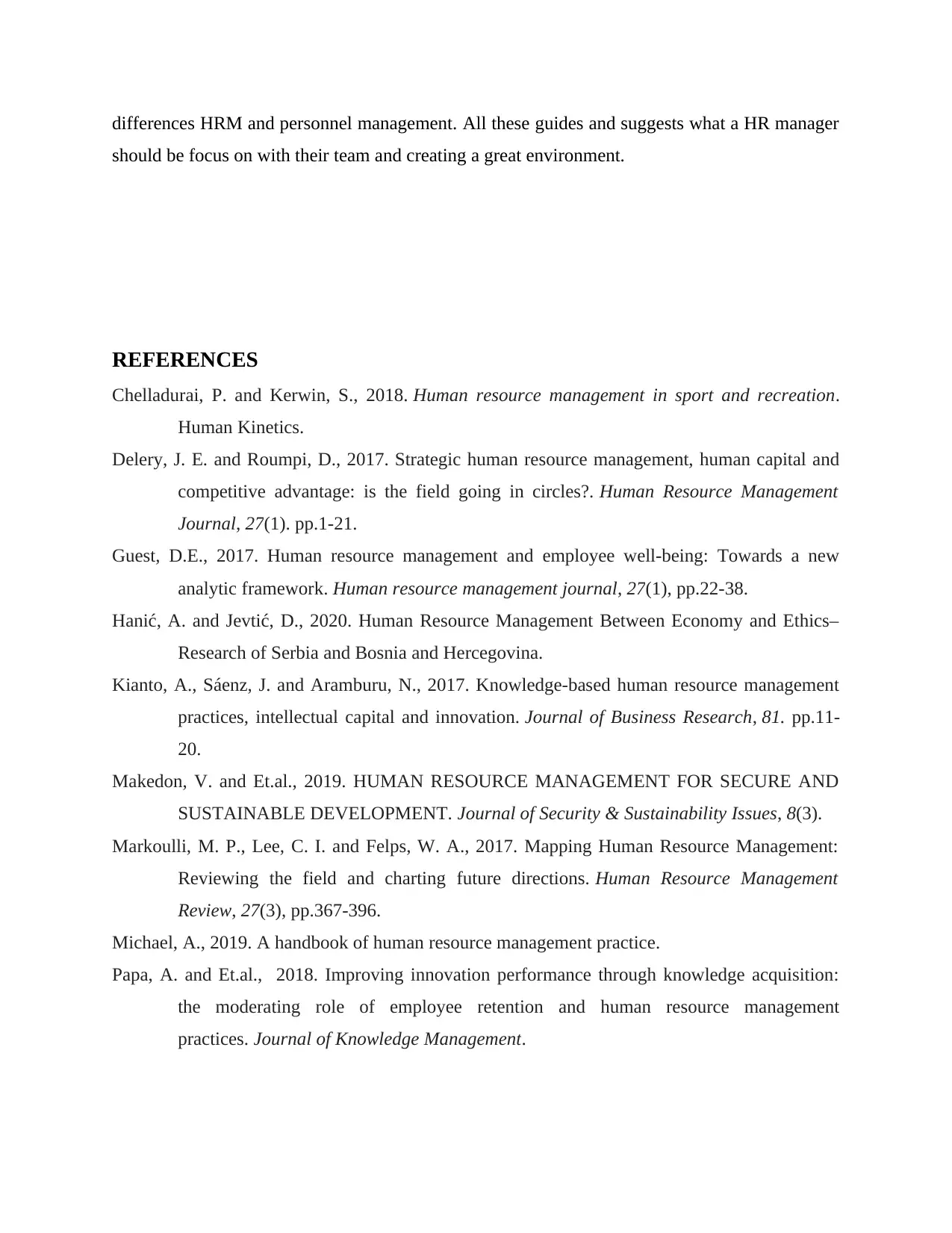
differences HRM and personnel management. All these guides and suggests what a HR manager
should be focus on with their team and creating a great environment.
REFERENCES
Chelladurai, P. and Kerwin, S., 2018. Human resource management in sport and recreation.
Human Kinetics.
Delery, J. E. and Roumpi, D., 2017. Strategic human resource management, human capital and
competitive advantage: is the field going in circles?. Human Resource Management
Journal, 27(1). pp.1-21.
Guest, D.E., 2017. Human resource management and employee well‐being: Towards a new
analytic framework. Human resource management journal, 27(1), pp.22-38.
Hanić, A. and Jevtić, D., 2020. Human Resource Management Between Economy and Ethics–
Research of Serbia and Bosnia and Hercegovina.
Kianto, A., Sáenz, J. and Aramburu, N., 2017. Knowledge-based human resource management
practices, intellectual capital and innovation. Journal of Business Research, 81. pp.11-
20.
Makedon, V. and Et.al., 2019. HUMAN RESOURCE MANAGEMENT FOR SECURE AND
SUSTAINABLE DEVELOPMENT. Journal of Security & Sustainability Issues, 8(3).
Markoulli, M. P., Lee, C. I. and Felps, W. A., 2017. Mapping Human Resource Management:
Reviewing the field and charting future directions. Human Resource Management
Review, 27(3), pp.367-396.
Michael, A., 2019. A handbook of human resource management practice.
Papa, A. and Et.al., 2018. Improving innovation performance through knowledge acquisition:
the moderating role of employee retention and human resource management
practices. Journal of Knowledge Management.
should be focus on with their team and creating a great environment.
REFERENCES
Chelladurai, P. and Kerwin, S., 2018. Human resource management in sport and recreation.
Human Kinetics.
Delery, J. E. and Roumpi, D., 2017. Strategic human resource management, human capital and
competitive advantage: is the field going in circles?. Human Resource Management
Journal, 27(1). pp.1-21.
Guest, D.E., 2017. Human resource management and employee well‐being: Towards a new
analytic framework. Human resource management journal, 27(1), pp.22-38.
Hanić, A. and Jevtić, D., 2020. Human Resource Management Between Economy and Ethics–
Research of Serbia and Bosnia and Hercegovina.
Kianto, A., Sáenz, J. and Aramburu, N., 2017. Knowledge-based human resource management
practices, intellectual capital and innovation. Journal of Business Research, 81. pp.11-
20.
Makedon, V. and Et.al., 2019. HUMAN RESOURCE MANAGEMENT FOR SECURE AND
SUSTAINABLE DEVELOPMENT. Journal of Security & Sustainability Issues, 8(3).
Markoulli, M. P., Lee, C. I. and Felps, W. A., 2017. Mapping Human Resource Management:
Reviewing the field and charting future directions. Human Resource Management
Review, 27(3), pp.367-396.
Michael, A., 2019. A handbook of human resource management practice.
Papa, A. and Et.al., 2018. Improving innovation performance through knowledge acquisition:
the moderating role of employee retention and human resource management
practices. Journal of Knowledge Management.
⊘ This is a preview!⊘
Do you want full access?
Subscribe today to unlock all pages.

Trusted by 1+ million students worldwide
1 out of 13
Related Documents
Your All-in-One AI-Powered Toolkit for Academic Success.
+13062052269
info@desklib.com
Available 24*7 on WhatsApp / Email
![[object Object]](/_next/static/media/star-bottom.7253800d.svg)
Unlock your academic potential
Copyright © 2020–2025 A2Z Services. All Rights Reserved. Developed and managed by ZUCOL.



